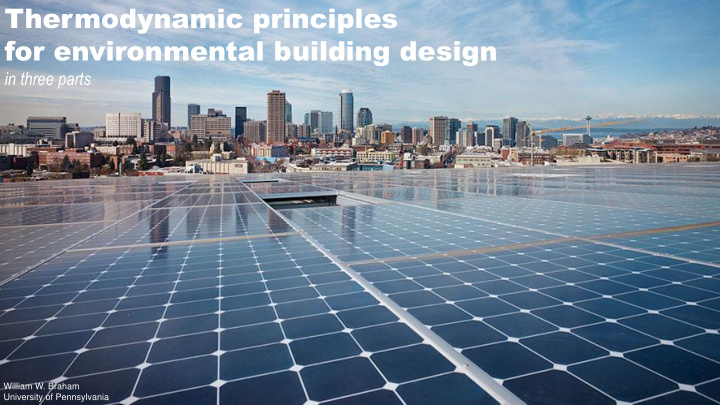



Thermodynamic principles for environmental building design in three parts William W. Braham University of Pennsylvania
H – Human T – Technological N - Natural
Princeton Passive Solar Greenhouse, 1978-79
Miller Hull Bulli ullitt tt Cen enter, ter, Sea Seattle, ttle, Wa Wa 2014
Eff Efficiency iciency 1 st & 2 nd law
Orga Organization nization
E[ E[m]er m]ergy gy sy synthe nthesis sis Cumulative energy dissipated in production of resources
U Cinncinnatti, Solar Decathlon, 2009
The Therm rmody odynam namic or ic organ ganizat ization of ion of co compl mplex ex, sel , self-organ organizing eco izing ecosys system tems R. Lindeman, “Dynamic - Tropic Aspect of Ecology,” 1942
Three system principles: 4 The Lotka – Odum principle of maximum maximum e[m]po e[m]power er as the selection goal toward which self-organizing systems evolve over time. 5 The Lindeman – Odum principle of ener energy y tr transf ansfor orma mation tion hier hierar archies hies , which emerge over time to achieve maximum e[m]power. 6 The Odum-Holling principle of ma material terial concen concentr tration tion hier hierar archies hies , closely coupled to energy transformation hierarchies, which cycle or pulse at different spatial and temporal scales to achieve maximum e[m]power. Odum, Systems Ecology, 1983
The Thermo rmody dynami namic orga c organiza nization of tion of bu buildi ildings ngs & cit & cities ies
Miller Hull Bulli ullitt tt Cen enter, ter, Sea Seattle, ttle, Wa Wa 2014
[the three parts]
Bui Buildings ldings re regu gulate late fl flows ows of r of res esources ources Purch Pu rchased ased hi high gh-quality, quality, high hi gh-intensit intensity y re resource sources Enviro Env ironmental, nmental, low low-density density re resources sources
Original Original ver ersion sion with normative utilities Improved Impr ed ver ersion sion with lower utilities Uti Utilities lities Passivh assivhaus us version ion with NZE photovoltaics Ellis House , 1964
1.470 x 10 12 J Open Bldg The Ellis House contains 833 m 3 of air. It would take 1.47 x 10 12 J to keep 0.197 x 10 12 J Original a completely open shelter 0.076 x 10 12 J at 20 ° C through a typical Improved 0.056 x 10 12 J Passivhaus Philadelphia year
Orig Origina inal l ve version rsion wi with th norma normative tive uti utilities lities 197,000,000,000 J 49,900,000,000,000,000 sej
Original Original ver ersion sion with normative utilities Hier Hierar archy hy of e[m]ergy Intensities
Orig Origina inal l ve version rsion un unco comfo mfortable rtable 86% 86% Pas Passivhaus sivhaus ins insulatio ulation unc uncomfo omfortable rtable 77% 77%
Wor Work of mana k of managin ging window g windows: open s: opening ing & cl & closin osing g shu shutte tters, shad rs, shades es, and w , and wind indows ows
Pas Passivhaus sivhaus ins insulatio ulation n with “smart” control: Win Windows dows ope opened ned and and or or sh shaded aded acc accord ording ing to to ind indoor oor and and out outdoor door te temperature mperature un unco comfo mfortable rtable 8% 8%
e[ e[m]ergy m]ergy int intensity ensity of of lab labor or to manag to manage windows e windows
Int Intellige elligenc nce of e of Build Building ing En Enve velopes lopes
Ne New hie w hierarchies rarchies of of e[ e[m]ergy m]ergy int intensity ensity
Ne New hie w hierarchies rarchies of of e[ e[m]ergy m]ergy int intensity ensity
Water Wastewater Material Flows Food Supplies Trash Greater transformity Less material Labor Fuels Concentrated Flows Electricity Information Currency
Original Original ver ersion sion with normative utilities Improved Impr ed ver ersion sion with lower utilities Passivh assivhaus us version ion with NZE photovoltaics Se Setting tting Ellis House , 1964
People, buildings, & devices coevolve
What people do with their time Fred McNabb, House of the Future ,1956
Location (site) within socio-economic hierarchies Abel, “Systems diagrams for visualizing macro - economics,” 2004
Location (site) within urban land-use hierarchies Huang, “Urban Hierarchy,” 2001
Cities by themselves are not sustainable , they gather & concentrate the resources of their region
Designing the Renewable City: The The New New Chaut Chautauqua auqua G Game ame William W. Braham Jill Sornson Kurtz Luke Butcher Mostapha Sadeghipour
Land Land Use Use
Environmental Environme ntal Res Resources ources wa wate ter fores for est natura nat ural agric agr iculture ulture Land Use In Lan d Use Inte tensit nsity de develope veloped
Support Lan Support Land
Land in distant past
Chautauqua, NY
H – Human T – Technological N - Natural
Thermodynamic principles for environmental building design in three parts William W. Braham University of Pennsylvania
Recommend
More recommend